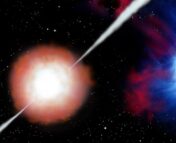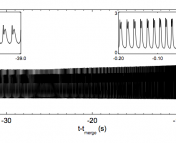Paper Title:A tera-electronvolt afterglow from a narrow jet in an extremely bright gamma-ray burst 221009A
Authors: LHAASO Collaboration
Status: published in Science, open access
On October 9th, 2022, an extraordinarily bright Long Gamma-ray Burst (LGRB, here just referred to as GRB), GRB 221009A, made a huge splash in the astronomy community. It was initially reported by the Gamma-ray Burst Monitor (GBM) onboard NASA’s Fermi satellite, prompting follow-ups by many other experiments across the electromagnetic spectrum. It broke records for its brightness, and was nicknamed the “brightest of all time.”
Long GRBs come from the deaths of extremely massive stars. They release a huge amount of energy when the star collapses, which we can observe in many wavelengths. This GRB was seen across the electromagnetic spectrum, by a huge number of telescopes and observatories. It is relatively nearby (redshift of 0.151), making it exciting for follow-ups, and in the plane of our galaxy. One of the most exciting real-time reports received when this GRB occurred was the notification from the LHAASO collaboration that they had observed more than 5000 very-high-energy (VHE) photons from GRB 221009A and the first detection of photons above 10 TeV from a GRB.
The Large High Altitude Air Shower Observatory (LHAASO) is a detector array in Sichuan, China that is sensitive to very-high-energy (VHE) and ultra-high-energy (UHE) photons. These are gamma-rays with energies between about 100 GeV (1011 eV) to PeV (1015 eV), which interact in our atmosphere to produce a shower of particles that can be detected by the experiment. The LHAASO collaboration has just released their first catalog of sources, and has also detected some of the highest energy gamma-ray sources in our universe.

Many astronomers have been anxiously awaiting the full paper describing the LHAASO observations of this extraordinary GRB – and that day is finally here! Today’s paper describes the LHAASO detection of GRB 221009A.
An extraordinary view of an extraordinary GRB
This GRB occurred in the field of view of LHAASO, and they were able to observe it for about 6000 seconds (1 hour and 40 minutes) before it moved out of the field of view. They saw over 64,000 photons with energies between 200 GeV to 7 TeV from the GRB. The light curve that was seen by LHAASO can be seen in Figure 1.

In lower energy gamma rays, Fermi-GBM saw an initial pulse, followed by an extraordinarily bright period about 220 seconds later. The TeV gamma-rays seen by LHAASO occur only a few seconds after the beginning of that brightest phase seen by Fermi-GBM.
At these high energies, these photons often interact with the Extragalactic Background Light (EBL) along their path towards earth. The EBL is the collection of the cosmic background light in the ultraviolet to infrared band (the cosmic microwave background is similar, but in the microwave band, rather than these shorter wavelengths). As these TeV photons travel toward the Earth many of them are absorbed and are thus lost. In order to get the intrinsic spectrum of the source, the authors correct for this effect by de-absorbing the spectrum, and the result is shown in Figure 2.

The authors are also able to calculate parameters of the GRB at its source, including properties about its relativistic jet. The authors use the light curve steepening to get the opening angle of the jet, which tells us how spread out the emission from the jet was. They calculate this angle to be about 0.8 degrees, indicating that the bright core of GRB 221009A’s narrow jet was pointed towards Earth, which they postulate is why this GRB was so bright at Earth.
Astrobite edited by: Jack Lubin
Featured image credit: NASA/Swift, Public domain, via Wikimedia Commons (edited)
edit: clarify this was the first detection of photons above 10 TeV from a GRB




